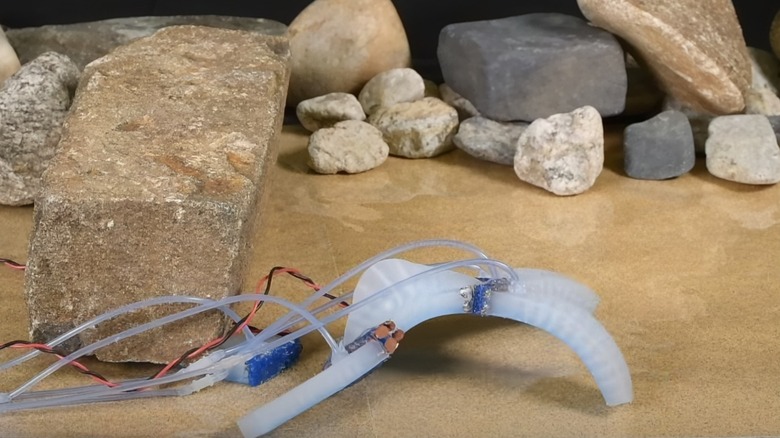Meet The Robot That Amputates Its Own Limbs To Survive
The robotic age is well and truly upon us, advancing at a breakneck pace. Debates over whether AI is good or bad will undeniably rage, but the truth is that it can go both ways. The most encouraging developments in AI and robotics are those that could potentially save human lives through medicine and emergency services. One of the latest breakthroughs in this field has raised eyebrows for taking a rather unorthodox approach to robotics. It's a robot designed to break itself, and by doing so, it could actually outlive the usage of most robots we have today.
In May of 2024, researchers from Yale University revealed a new step in robotics in the journal Advanced Materials. Their invention looks inauspicious at first, being only about the size of your palm with four crab-like legs. What makes this robot revolutionary, however, is the fact that it can detach its own limbs if they become damaged. It's similar to the way that a gecko can detach its tail if a predator grabs hold of it, but robots don't have predators, so what's the point here?
This new development in robotics is still in its infant stages, but it has the potential to revolutionize search-and-rescue missions. In situations where large structures have collapsed and trapped people, robots could rescue them without risking more human lives. However, such sites are full of hazards, like collapsing rubble that could fall on the robot. With detachable limbs, search-and-rescue robots could free themselves from traps and continue their missions.
The technology behind the limb-detaching robot
The work done by Yale roboticists is only the latest development in an emerging field called soft robotics. When you think of a robot, you probably picture something made out of metal or a similar solid, strong material. They are bound to a rigid, unchanging form, which means that there are limitations to their functionality, particularly regarding freedom of movement. The counter to this is a soft robot, meaning a robot whose form is highly flexible, making it a shape-shifter of sorts.
Soft robots are made with malleable materials called elastomers. An elastomer is any material composed of very large molecules called elastic polymers. Elastomers are flexible under force, but they spring back into their original form when that force is removed, not unlike a bread dough that springs back into place when you poke it. Soft robots may also include gels and fluids to make them even more malleable.
For their new robot, the team at Yale invented a new type of elastomer called a biocontinuous thermoplastic elastomer, which is an advancement of common thermoplastic polymers already in use. The new material is solid up to 284 degrees Fahrenheit, at which point it melts. When the temperature goes back down, the elastomer returns to its solid form. If one of the robot's legs becomes trapped, the elastomer heats up, melting the joint where the limb meets the body. This allows the robot to abandon its damaged appendage and march forward without damage to the main body.
The real-world inspiration behind this new technology
The technology behind Yale's new robot may be brand new, but its inspiration lies in ancient members of the natural world. Numerous animal species are capable of detaching their limbs or other extremities in emergency situations. A gecko, which can detach its tail if a predator gets ahold of it and later grow a new one, presents the most famous proof of the survival benefits of abandoning one's appendages. However, a starfish is an even closer comparison in the field of soft robotics, with its flexible body and ability to detach any one of its limbs in a moment of crisis.
One thing the robot lacks compared to its natural-world counterparts is the ability to regrow limbs, but repairs could be made manually by a roboticist. However, one particular issue that needs to be addressed is what becomes of the stranded limbs. The current materials used in the robot are not biodegradable, the way a shed limb returns to nature. One of the next steps in advancing this technology will be the potential of biodegradable materials to make it even more effective. Although the specialized nature of this technology may not be applicable to robots we use in everyday life, its potential in search-and-rescue scenarios alone makes it one of the most exciting breakthroughs in recent memory.


